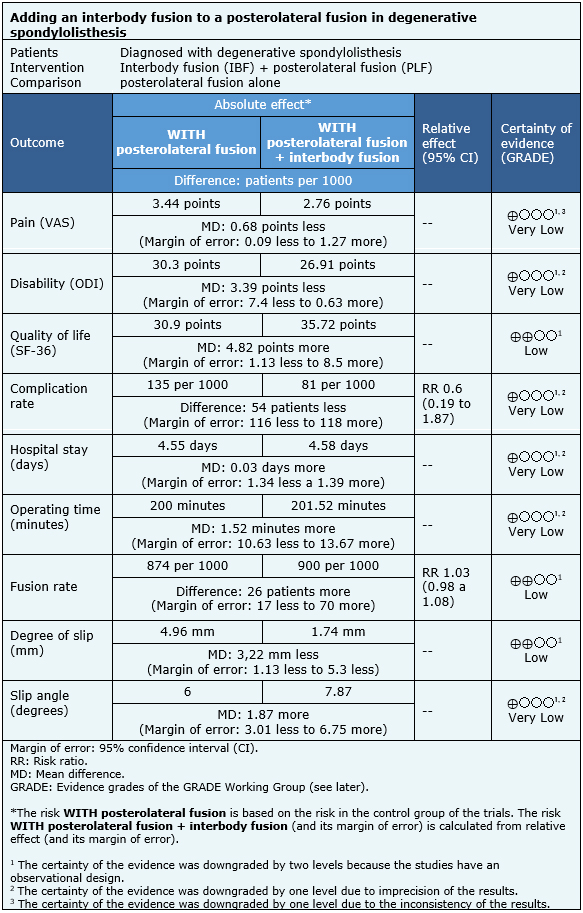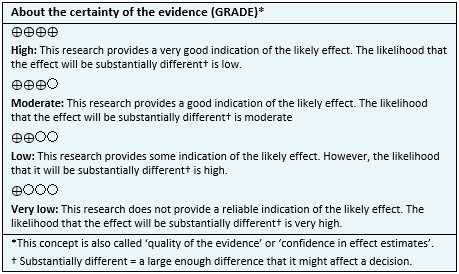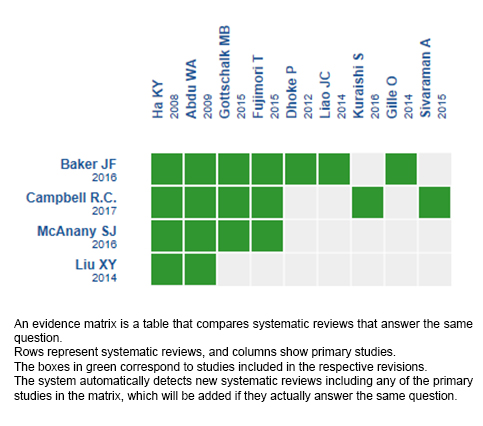 Para Descargar PDF debe Abrir sesión.
Para Descargar PDF debe Abrir sesión.
INTRODUCTION
Surgical treatment of lumbar degenerative spondylolisthesis usually involves an interbody fusion in addition to a posterolateral fusion. However, the value of this procedure has not been established.
METHODS
To answer this question we used Epistemonikos, the largest database of systematic reviews in health, which is maintained by screening multiple information sources, including MEDLINE, EMBASE, Cochrane, among others. We extracted data from the systematic reviews, reanalyzed data of primary studies, conducted a meta-analysis and generated a summary of findings table using the GRADE approach.
RESULTS AND CONCLUSIONS
We identified four systematic reviews, including nine primary studies; none of them randomized. We concluded performing interbody fusion in addition to posterolateral fusion during the surgical treatment of lumbar degenerative spondylolisthesis might decrease vertebral body slippage and lead to a slight improvement in quality of life. However, it is associated with higher costs.
Spondylolisthesis corresponds to the slippage of one vertebra over the lower one; degenerative spondylolisthesis is secondary to a degenerative process of the articular facets and the intervertebral disc. Degenerative spondylolisthesis is a cause of lumbar pain, radicular pain, and neurological claudication.
Surgical treatment of degenerative spondylolisthesis aims to reduce pain and to improve function and quality of life by decompressing neural elements. Currently, there is consensus about the need of adding a fusion to the decompression, being the posterolateral fusion, with or without instrumentation, is the most frequently used approach.
The addition of an interbody fusion (IBF), either through an anterior, posterior or transforaminal approach has theoretical benefits since it would increase fusion rate. Moreover, an interbody fusion would stabilize the anterior column, which supports most of the body weight. However, an interbody fusion also carries a higher risk of complications and cost. So, the value of adding an interbody fusion to a posterolateral arthrodesis has not been established.
To answer the question, we used Epistemonikos, the largest database of systematic reviews in health, which is maintained by screening multiple information sources, including MEDLINE, EMBASE, Cochrane, among others, to identify systematic reviews and their included primary studies. We extracted data from the identified reviews and reanalyzed data from primary studies included in those reviews. With this information, we generated a structured summary denominated FRISBEE (Friendly Summary of Body of Evidence using Epistemonikos) using a pre-established format, which includes key messages, a summary of the body of evidence (presented as an evidence matrix in Epistemonikos), meta-analysis of the total of studies when it is possible, a summary of findings table following the GRADE approach and a table of other considerations for decision-making.
|
Key messages
|
|
What is the evidence. |
We found four systematic reviews [1],[2],[3],[4], including nine primary studies [5],[6],[7],[8],[9],[10],[11],[12],[13]; none of them corresponding to a randomized trial. Two were prospective cohorts [5],[13] and seven were retrospective cohort studies [6],[7],[8],[9],[10],[11],[12]. One study was excluded from the analysis [13] because it compared two types of lumbar interbody fusion. |
|
What types of patients were included* |
All of the studies included patients with lumbar degenerative spondylolisthesis. The average age ranged from 56 to 70 years in the different studies. |
|
What types of interventions were included* |
Regarding the type of intervention, all of the studies added an interbody fusion to a posterolateral arthrodesis. Regarding the type of interbody fusion, five studies used a posterior approach [5],[9],[10],[11],[12] and three used a transforaminal approach [6],[7],[8]. Regarding the comparison, all of the studies compared against posterolateral fusion alone. |
|
What types of outcomes |
The systematic reviews grouped the outcomes as follows:
The average follow-up of the studies was 32 months, with a range of 12 to 53 months. |
* The information about primary studies is extracted from the systematic reviews identified, unless otherwise specified.
● Adding an interbody fusion to the posterolateral fusion during the surgical treatment of degenerative spondylolisthesis might decrease slippage of the vertebral body, and could slightly improve quality of life.
● It is not clear whether adding an interbody fusion improves fusion rate or clinical outcomes such as pain or disability.
The information on the effects of adding an interbody fusion to a posterolateral fusion in degenerative lumbar spondylolisthesis was based on five studies including 582 patients in total [5],[7],[9],[10],[11].
The remaining three studies [6],[8],[12] were not included in the analysis as none of the identified systematic reviews was able to extract data suitable for meta-analysis from them.
Three studies evaluated pain (277 patients) [7],[9],[10]; three studies assessed disability (277 patients) [7],[9],[10]; three studies determined quality of life (511 patients) [5],[7],[9]; four studies determined complication rate (542 patients) [5],[7],[9],[11]; two studies assessed hospital stay (455 patients) [5],[9]; three studies measured operating time (511 patients), [5],[7],[9]; five studies evaluated fusion rate (521 patients) [5],[7],[9],[10],[11]; two studies measured the degree of slip of the vertebral body (87 patients) [7],[11] and three studies assessed slip angle (127 patients) [7],[10],[11].
The summary of findings is as follows:


|
To whom this evidence does and does not apply |
|
| About the outcomes included in this summary |
|
| Balance between benefits and risks, and certainty of the evidence |
|
| Resource considerations |
|
| What would patients and their doctors think about this intervention |
|
|
Differences between this summary and other sources |
|
| Could this evidence change in the future? |
|
Using automated and collaborative means, we compiled all the relevant evidence for the question of interest and we present it as a matrix of evidence.

Follow the link to access the interactive version: Posterolateral fusion with or without interbody fusion for lumbar degenerative spondylolisthesis
The upper portion of the matrix of evidence will display a warning of “new evidence” if new systematic reviews are published after the publication of this summary. Even though the project considers the periodical update of these summaries, users are invited to comment in Medwave or to contact the authors through email if they find new evidence and the summary should be updated earlier.
After creating an account in Epistemonikos, users will be able to save the matrixes and to receive automated notifications any time new evidence potentially relevant for the question appears.
This article is part of the Epistemonikos Evidence Synthesis project. It is elaborated with a pre-established methodology, following rigorous methodological standards and internal peer review process. Each of these articles corresponds to a summary, denominated FRISBEE (Friendly Summary of Body of Evidence using Epistemonikos), whose main objective is to synthesize the body of evidence for a specific question, with a friendly format to clinical professionals. Its main resources are based on the evidence matrix of Epistemonikos and analysis of results using GRADE methodology. Further details of the methods for developing this FRISBEE are described here (http://dx.doi.org/10.5867/medwave.2014.06.5997)
Epistemonikos foundation is a non-for-profit organization aiming to bring information closer to health decision-makers with technology. Its main development is Epistemonikos database (www.epistemonikos.org).
Potential conflicts of interest
The authors do not have relevant interests to declare.
 Esta obra de Medwave está bajo una licencia Creative Commons Atribución-NoComercial 3.0 Unported. Esta licencia permite el uso, distribución y reproducción del artículo en cualquier medio, siempre y cuando se otorgue el crédito correspondiente al autor del artículo y al medio en que se publica, en este caso, Medwave.
Esta obra de Medwave está bajo una licencia Creative Commons Atribución-NoComercial 3.0 Unported. Esta licencia permite el uso, distribución y reproducción del artículo en cualquier medio, siempre y cuando se otorgue el crédito correspondiente al autor del artículo y al medio en que se publica, en este caso, Medwave.

INTRODUCTION
Surgical treatment of lumbar degenerative spondylolisthesis usually involves an interbody fusion in addition to a posterolateral fusion. However, the value of this procedure has not been established.
METHODS
To answer this question we used Epistemonikos, the largest database of systematic reviews in health, which is maintained by screening multiple information sources, including MEDLINE, EMBASE, Cochrane, among others. We extracted data from the systematic reviews, reanalyzed data of primary studies, conducted a meta-analysis and generated a summary of findings table using the GRADE approach.
RESULTS AND CONCLUSIONS
We identified four systematic reviews, including nine primary studies; none of them randomized. We concluded performing interbody fusion in addition to posterolateral fusion during the surgical treatment of lumbar degenerative spondylolisthesis might decrease vertebral body slippage and lead to a slight improvement in quality of life. However, it is associated with higher costs.
 Autores:
Arturo Meissner-Haecker[1,2], Julio Urrutia[2,3]
Autores:
Arturo Meissner-Haecker[1,2], Julio Urrutia[2,3]

Citación: Meissner-Haecker A, Urrutia J. Does adding interbody fusion to posterolateral fusion increase success in the surgical management of degenerative lumbar spondylolisthesis?. Medwave 2018 Ene-Feb;18(1):e7146 doi: 10.5867/medwave.2018.01.7146
Fecha de envío: 27/12/2017
Fecha de aceptación: 29/12/2017
Fecha de publicación: 30/1/2018
Origen: Este artículo es producto del Epistemonikos Evidence Synthesis Project de la Fundación Epistemonikos, en colaboración con Medwave para su publicación.
Tipo de revisión: Con revisión por pares sin ciego por parte del equipo metodológico del Epistemonikos Evidence Synthesis Project.

Nos complace que usted tenga interés en comentar uno de nuestros artículos. Su comentario será publicado inmediatamente. No obstante, Medwave se reserva el derecho a eliminarlo posteriormente si la dirección editorial considera que su comentario es: ofensivo en algún sentido, irrelevante, trivial, contiene errores de lenguaje, contiene arengas políticas, obedece a fines comerciales, contiene datos de alguna persona en particular, o sugiere cambios en el manejo de pacientes que no hayan sido publicados previamente en alguna revista con revisión por pares.
Aún no hay comentarios en este artículo.
Para comentar debe iniciar sesión
 Medwave publica las vistas HTML y descargas PDF por artículo, junto con otras métricas de redes sociales.
Medwave publica las vistas HTML y descargas PDF por artículo, junto con otras métricas de redes sociales.
 Baker JF, Errico TJ, Kim Y, Razi A. Degenerative spondylolisthesis: contemporary review of the role of interbody fusion. Eur J Orthop Surg Traumatol. 2017 Feb;27(2):169-180. | CrossRef | PubMed |
Baker JF, Errico TJ, Kim Y, Razi A. Degenerative spondylolisthesis: contemporary review of the role of interbody fusion. Eur J Orthop Surg Traumatol. 2017 Feb;27(2):169-180. | CrossRef | PubMed | Campbell RC, Mobbs RJ, Lu VM, Xu J, Rao PJ, Phan K. posterolateral Fusion Versus Interbody Fusion for Degenerative Spondylolisthesis: Systematic Review and Meta-Analysis. Global Spine J. 2017 Aug;7(5):482-490. | CrossRef | PubMed | PMC |
Campbell RC, Mobbs RJ, Lu VM, Xu J, Rao PJ, Phan K. posterolateral Fusion Versus Interbody Fusion for Degenerative Spondylolisthesis: Systematic Review and Meta-Analysis. Global Spine J. 2017 Aug;7(5):482-490. | CrossRef | PubMed | PMC | Liu XY, Wang YP, Qiu GX, Weng XS, Yu B. Meta-analysis of circumferential fusion versus posterolateral fusion in lumbar spondylolisthesis. J Spinal Disord Tech. 2014 Dec;27(8):E282-93. | CrossRef | PubMed |
Liu XY, Wang YP, Qiu GX, Weng XS, Yu B. Meta-analysis of circumferential fusion versus posterolateral fusion in lumbar spondylolisthesis. J Spinal Disord Tech. 2014 Dec;27(8):E282-93. | CrossRef | PubMed | McAnany SJ, Baird EO, Qureshi SA, Hecht AC, Heller JG, Anderson PA. Posterolateral Fusion Versus Interbody Fusion for Degenerative Spondylolisthesis: A Systematic Review and Meta-Analysis. Spine (Phila Pa 1976). 2016 Dec 1;41(23):E1408-E1414. Review. | PubMed |
McAnany SJ, Baird EO, Qureshi SA, Hecht AC, Heller JG, Anderson PA. Posterolateral Fusion Versus Interbody Fusion for Degenerative Spondylolisthesis: A Systematic Review and Meta-Analysis. Spine (Phila Pa 1976). 2016 Dec 1;41(23):E1408-E1414. Review. | PubMed | Abdu WA, Lurie JD, Spratt KF, Tosteson AN, Zhao W, Tosteson TD, Herkowitz H, Longely M, Boden SD, Emery S, Weinstein JN. Degenerative spondylolisthesis: does fusion method influence outcome? Four-year results of the spine patient outcomes research trial. Spine (Phila Pa 1976). 2009 Oct 1;34(21):2351-60. | CrossRef | PubMed | PMC |
Abdu WA, Lurie JD, Spratt KF, Tosteson AN, Zhao W, Tosteson TD, Herkowitz H, Longely M, Boden SD, Emery S, Weinstein JN. Degenerative spondylolisthesis: does fusion method influence outcome? Four-year results of the spine patient outcomes research trial. Spine (Phila Pa 1976). 2009 Oct 1;34(21):2351-60. | CrossRef | PubMed | PMC | Dhoke P, Goss B, Mehta S, Stanojevic S, Williams R. In the era of recombinant BMP, does additional anterior stabilization add value to a posterolateral fusion? Evid Based Spine Care J. 2012 Nov;3(4):21-5. | CrossRef | PubMed | PMC |
Dhoke P, Goss B, Mehta S, Stanojevic S, Williams R. In the era of recombinant BMP, does additional anterior stabilization add value to a posterolateral fusion? Evid Based Spine Care J. 2012 Nov;3(4):21-5. | CrossRef | PubMed | PMC | Fujimori T, Le H, Schairer WW, Berven SH, Qamirani E, Hu SS. Does Transforaminal Lumbar Interbody Fusion Have Advantages over posterolateral Lumbar Fusion for Degenerative Spondylolisthesis? Global Spine J. 2015 Apr;5(2):102-9. | CrossRef | PubMed | PMC |
Fujimori T, Le H, Schairer WW, Berven SH, Qamirani E, Hu SS. Does Transforaminal Lumbar Interbody Fusion Have Advantages over posterolateral Lumbar Fusion for Degenerative Spondylolisthesis? Global Spine J. 2015 Apr;5(2):102-9. | CrossRef | PubMed | PMC | Gille O, Challier V, Parent H, Cavagna R, Poignard A, Faline A, Fuentes S, Ricart O, Ferrero E, Ould Slimane M; French Society of Spine Surgery (SFCR). Degenerative lumbar spondylolisthesis: cohort of 670 patients, and proposal of a new classification. Orthop Traumatol Surg Res. 2014 Oct;100(6 Suppl):S311-5. | CrossRef | PubMed |
Gille O, Challier V, Parent H, Cavagna R, Poignard A, Faline A, Fuentes S, Ricart O, Ferrero E, Ould Slimane M; French Society of Spine Surgery (SFCR). Degenerative lumbar spondylolisthesis: cohort of 670 patients, and proposal of a new classification. Orthop Traumatol Surg Res. 2014 Oct;100(6 Suppl):S311-5. | CrossRef | PubMed | Gottschalk MB, Premkumar A, Sweeney K, Boden SD, Heller J, Yoon ST, Rhee JM, Leckie SK, Braly B, Simpson AK, Lenehan E. posterolateral Lumbar Arthrodesis With and Without Interbody Arthrodesis for L4-L5 Degenerative Spondylolisthesis: A Comparative Value Analysis. Spine (Phila Pa 1976). 2015 Jun 15;40(12):917-25. | CrossRef | PubMed |
Gottschalk MB, Premkumar A, Sweeney K, Boden SD, Heller J, Yoon ST, Rhee JM, Leckie SK, Braly B, Simpson AK, Lenehan E. posterolateral Lumbar Arthrodesis With and Without Interbody Arthrodesis for L4-L5 Degenerative Spondylolisthesis: A Comparative Value Analysis. Spine (Phila Pa 1976). 2015 Jun 15;40(12):917-25. | CrossRef | PubMed | Ha KY, Na KH, Shin JH, Kim KW. Comparison of posterolateral fusion with and without additional posterior lumbar interbody fusion for degenerative lumbar spondylolisthesis. J Spinal Disord Tech. 2008 Jun;21(4):229-34. | CrossRef | PubMed |
Ha KY, Na KH, Shin JH, Kim KW. Comparison of posterolateral fusion with and without additional posterior lumbar interbody fusion for degenerative lumbar spondylolisthesis. J Spinal Disord Tech. 2008 Jun;21(4):229-34. | CrossRef | PubMed | Kuraishi S, Takahashi J, Mukaiyama K, Shimizu M, Ikegami S, Futatsugi T, Hirabayashi H, Ogihara N, Hashidate H, Tateiwa Y, Kinoshita H, Kato H. Comparison of Clinical and Radiological Results of posterolateral Fusion and Posterior Lumbar Interbody Fusion in the Treatment of L4 Degenerative Lumbar Spondylolisthesis. Asian Spine J. 2016 Feb;10(1):143-52. | CrossRef | PubMed | PMC |
Kuraishi S, Takahashi J, Mukaiyama K, Shimizu M, Ikegami S, Futatsugi T, Hirabayashi H, Ogihara N, Hashidate H, Tateiwa Y, Kinoshita H, Kato H. Comparison of Clinical and Radiological Results of posterolateral Fusion and Posterior Lumbar Interbody Fusion in the Treatment of L4 Degenerative Lumbar Spondylolisthesis. Asian Spine J. 2016 Feb;10(1):143-52. | CrossRef | PubMed | PMC | Liao JC, Lu ML, Niu CC, Chen WJ, Chen LH. Surgical outcomes of degenerative lumbar spondylolisthesis with anterior vacuum disc: can the intervertebral cage overcome intradiscal vacuum phenomenon and enhance posterolateral fusion? J Orthop Sci. 2014 Nov;19(6):851-9. | CrossRef | PubMed |
Liao JC, Lu ML, Niu CC, Chen WJ, Chen LH. Surgical outcomes of degenerative lumbar spondylolisthesis with anterior vacuum disc: can the intervertebral cage overcome intradiscal vacuum phenomenon and enhance posterolateral fusion? J Orthop Sci. 2014 Nov;19(6):851-9. | CrossRef | PubMed | Sivaraman A, Altaf F, Jalgaonkar A, Kakkar R, Sirigiri PB, Howieson A, Crawford RJ. Prospective Study of Posterior Lumbar Interbody Fusion With Either Interbody Graft or Interbody Cage in the Treatment of Degenerative Spondylolisthesis. J Spinal Disord Tech. 2015 Oct;28(8):E467-71. | CrossRef | PubMed |
Sivaraman A, Altaf F, Jalgaonkar A, Kakkar R, Sirigiri PB, Howieson A, Crawford RJ. Prospective Study of Posterior Lumbar Interbody Fusion With Either Interbody Graft or Interbody Cage in the Treatment of Degenerative Spondylolisthesis. J Spinal Disord Tech. 2015 Oct;28(8):E467-71. | CrossRef | PubMed | Matz PG, Meagher RJ, Lamer T, Tontz WL Jr, Annaswamy TM, Cassidy RC, Cho CH, Dougherty P, Easa JE, Enix DE, Gunnoe BA, Jallo J, Julien TD, Maserati MB, Nucci RC, O'Toole JE, Rosolowski K, Sembrano JN, Villavicencio AT, Witt JP. Guideline summary review: An evidence-based clinical guideline for the diagnosis and treatment of degenerative lumbar spondylolisthesis. Spine J. 2016 Mar;16(3):439-48. | CrossRef | PubMed |
Matz PG, Meagher RJ, Lamer T, Tontz WL Jr, Annaswamy TM, Cassidy RC, Cho CH, Dougherty P, Easa JE, Enix DE, Gunnoe BA, Jallo J, Julien TD, Maserati MB, Nucci RC, O'Toole JE, Rosolowski K, Sembrano JN, Villavicencio AT, Witt JP. Guideline summary review: An evidence-based clinical guideline for the diagnosis and treatment of degenerative lumbar spondylolisthesis. Spine J. 2016 Mar;16(3):439-48. | CrossRef | PubMed |